The most common book format—pages bound to a spine—is known as a codex. Codices date to at least the 1st century CE and became prevalent due to their convenience, especially in comparison to long, cumbersome scrolls. Today, artists reimagine this familiar format to connect with or surprise viewers.
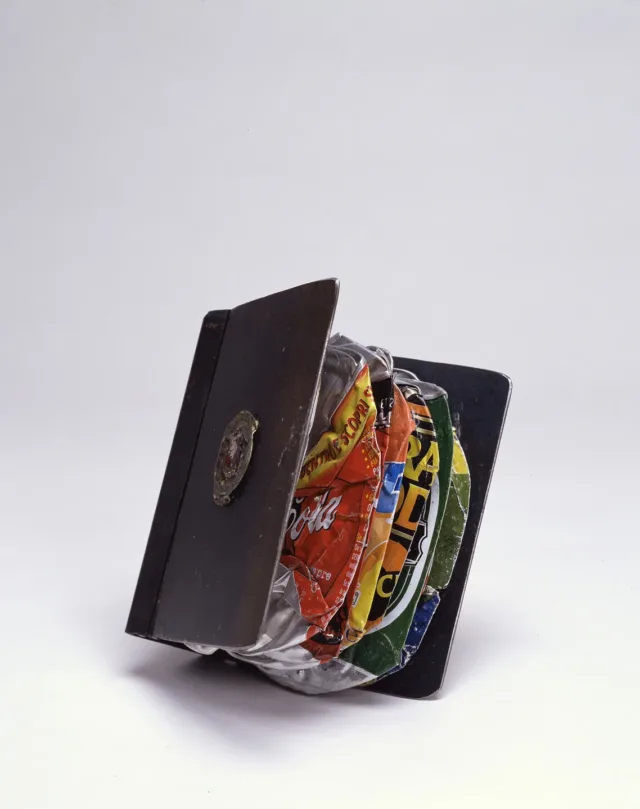
Mirella Bentivoglio, Book and Book clasp (from “Litolattine”), 1998; Iron, cans, and caps, 4 1/2 x 9 x 5 in.; National Museum of Women in the Arts, The Lois Pollard Price Acquisition Fund; © Mirella Bentivoglio
Ámbar Past (b. 1949) lives among the Tzotzil Maya in Chiapas, Mexico. The ancient Maya had a sophisticated written language and amassed rich libraries. Women were key contributors to this culture. Incantations by Mayan Women may be the first book written, illustrated, printed, and bound—on handmade paper—by the Maya in more than 500 years, and is the first volume of Mayan women’s poetry.
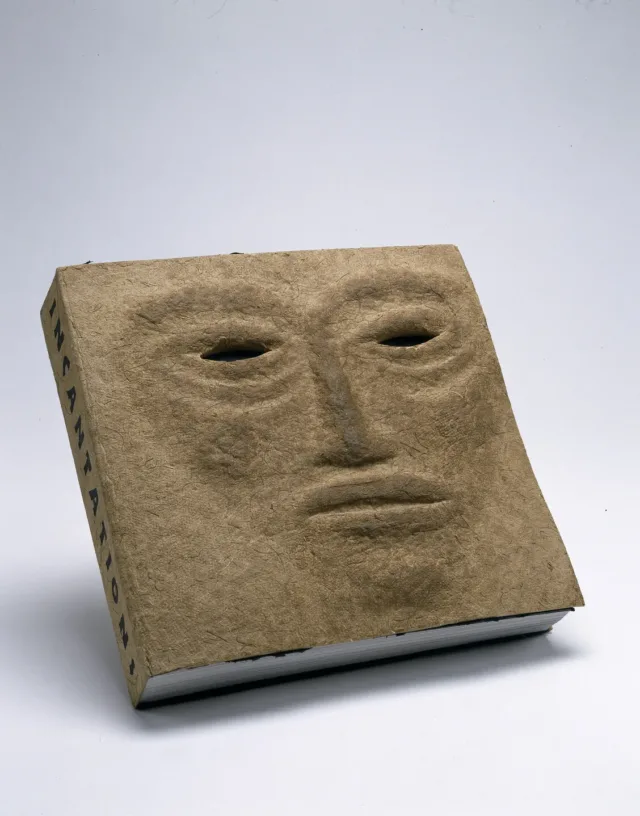
Ámbar Past, Incantations by Mayan Women, 2005; Silkscreen and offset printing, 10 x 10 in.; National Museum of Women in the Arts, Gift of Lynn M. Johnston
“Calling the Dead to Supper”
Dead Father:
Dead Mother:
Open your graves,
open your eyes.
Come rest your hearts.
Come rest your blood.
Your celebration is ready.
We are burning pitch pines.
to light your way
to our house.
Come eat with us.
Come drink with us.
Have a little atole,
a few tortillas.
Here’s a shot of the rum you like
to keep your eyes open.
We don’t see each other anymore,
nor can we talk,
nor eat together every day as we used to
on the surface of the Earth.
—María Álveres Jiménes, “Me’ Avrila”
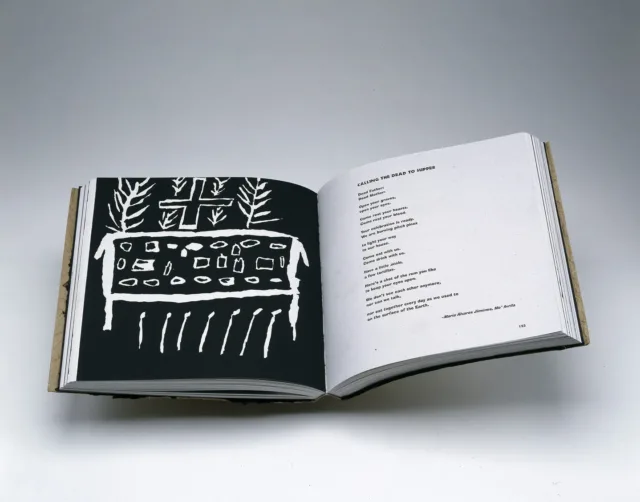
Ámbar Past, Incantations by Mayan Women, 2005; Silkscreen and offset printing, 10 x 10 in.; National Museum of Women in the Arts, Gift of Lynn M. Johnston
Spring is the result of a collaboration between Audrey Niffenegger (b. 1963) and Marilyn Sward (1941–2008), who created handmade paper for the pages. Niffenegger weaves a tale of a discontented young woman during a particularly rainy spring. In spite of her best efforts—including buying shoes, befriending a kitten, and writing stories of her own—nothing seems to brighten her mood.
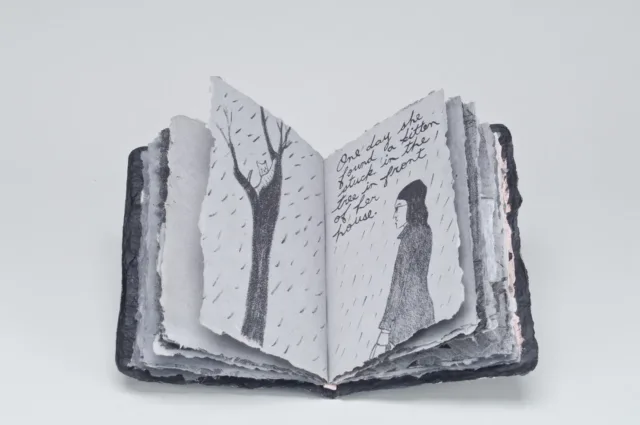
Audrey Niffenegger, Spring, 1993; Lithographs on handmade cotton and abaca paper with carbon and antique silver pigment, some hand colored with colored pencils; cover hand colored with acrylic paint, 6 x 4 1/4 in.; National Museum of Women in the Arts, Gift of the artist; © Audrey Niffenegger; Photo by Lee Stalsworth
Inspired by the biblical tale of Noah’s ark, After the Deluge by Susan Goethel Campbell (b. 1956) tells the comic and tragic stories of animals in the early 21st century. Text and images are based on journalists’ accounts of human encroachment into animal habitats. A faux-leather folder, closure resembling the constellation Columba (“the dove”), and list of animal species reinforce the book’s message.
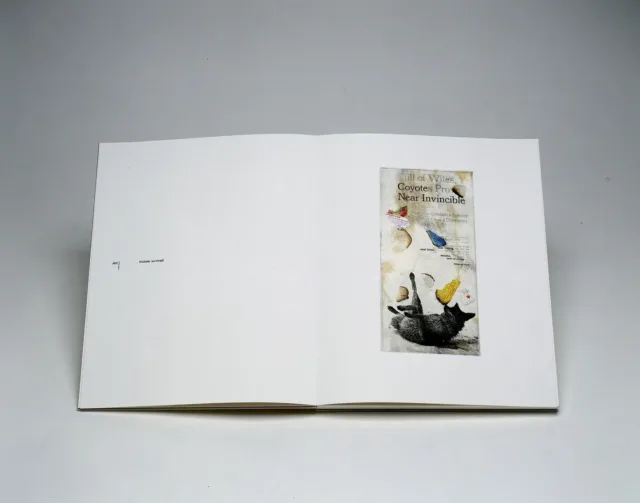
Susan Goethel Campbell, After the Deluge: The Post-Ark Report, 2002; Photoetching with aquatint and chine colle, 14 x 11 x 1 in.; National Museum of Women in the Arts, Museum Purchase; © Susan Goethel Campbell
Comment attirer les oiseaux? (How to attract birds?) addresses humans’ desire to tame the natural world and explores flight as a metaphor for freedom. The birds that Brenda Watson (b. 1964) depicted are common to the small community where she grew up. The book’s shape speaks to birds’ ability to travel between urban and rural landscapes, echoing her own experiences of migration.

Brenda Watson, Comment attirer les oiseaux (How to attract birds?), 1995; Oil paint on aluminum, rubber, thread, 30 x 10 in.; National Museum of Women in the Arts, Museum purchase: Library and Research Center Book Acquisition Fund
For Ghada Jamal (b. 1955), Back Ground is a return visit to her native Lebanon, set in a time before violence ended her youthful expectations. The layered landscape, arabesque design, patina, and patterns build a sense of serenity and continuity. Back Ground grieves the loss of innocence, mourns a dashed dream, and yearns for the beautiful, the mystical, and the permanent.
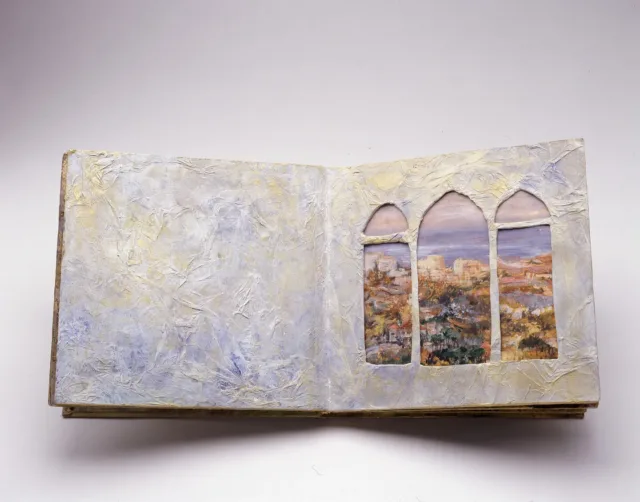
Ghada Jamal, Back Ground, 1995; Watercolor, acrylic, graphite, collage on paper, 9 3/4 x 9 3/4 in.; National Museum of Women in the Arts, Gift of the artist; © Ghada Jamal
When the Gulf War escalated in 1991, Nelleke Nix (b. 1939) heard radio and television interviews with civilians, especially those with loved ones in the target zones of Iraqi SCUD missiles. These reports reawakened war memories from the artist’s early childhood and compelled her to make 1940–45 Remembered, a first-person account of her family’s experiences in Holland during World War II.
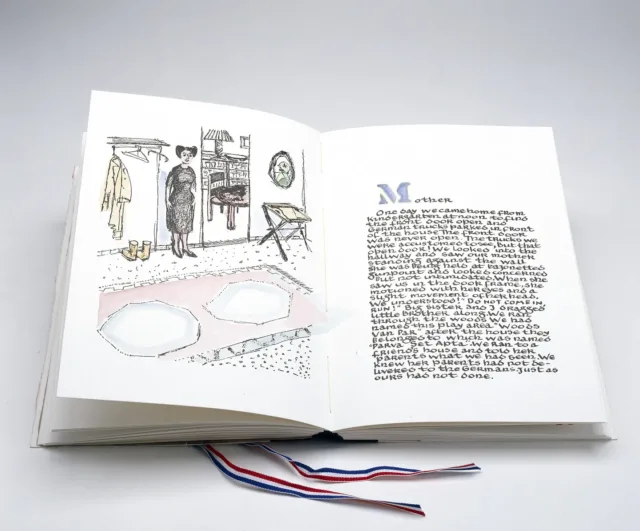
Nelleke Nix, 1940-1945 Remembered, 1991; Hand-colored block prints, collage and photo transfers on paper, stamps, fabric, ribbon, 7 1/2 x 10 1/2 in.; National Museum of Women in the Arts, Gift of the artist; © Nelleke Nix
Tatana Kellner (b. 1950) shares her parents’ recollections of the Holocaust in B-11226: Fifty Years of Silence. The book juxtaposes their handwritten Czech text with the artist’s English translations; historical family photographs with contemporary images of concentration camp sites. A cast of Kellner’s father’s arm with its ineradicable number ensures his presence through each page.
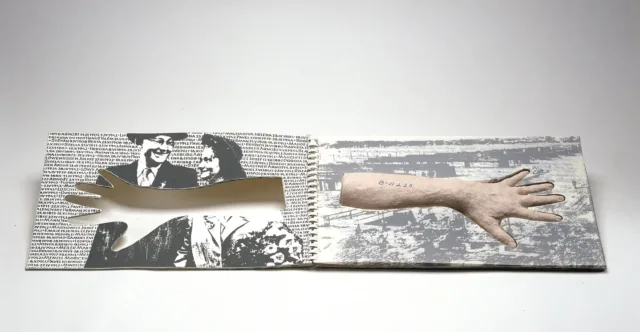
Tatana Kellner, B-11226: Fifty Years of Silence, not dated; Silkscreen, cast handmade paper, 12 x 20 in.; National Museum of Women in the Arts
Mirella Bentivoglio (1922–2017) responded to the tragic September 11 attacks on the U.S. by making The World after September 11, 2001: A Reinforced Book. Its wire mesh cover protects “fragile” contents—paper labels meant to be torn off and pasted onto shipping crates bound for all parts of the world. The artist built layers of meaning by using found objects and visual poetry.
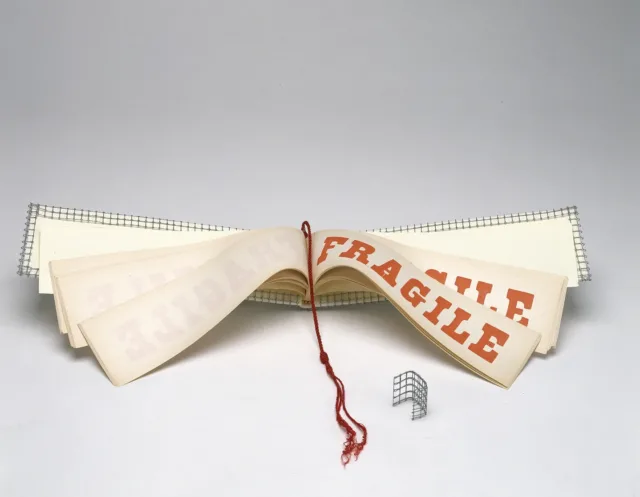
Mirella Bentivoglio, The World after September 11, 2001: A Reinforced Book, 2001; Wire, string, paper, 20 x 3 in.; National Museum of Women in the Arts, Gift of the artist; © Mirella Bentivoglio
Litolattine recalls the first books in art history made with unorthodox materials—Futurist books from the 1930s, which were constructed of cigar and sardine tins produced by the Litolatta company. Bentivoglio made this book with tin cans crushed in the street by vehicle tires: poetry written by city traffic. These found objects are charged with former lives and experiences.
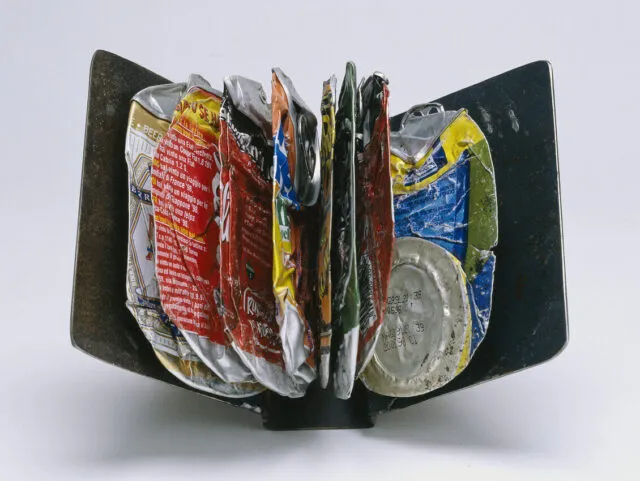
Mirella Bentivoglio, Book and Book clasp (from “Litolattine”), 1998; Iron, cans, and caps, 4 1/2 x 9 x 5 in.; National Museum of Women in the Arts, The Lois Pollard Price Acquisition Fund; © Mirella Bentivoglio
In Wheeling, Ruth Laxson (1924–2019) confronts the car-centric culture in which we live. Organized into episodic chapters, this book describes the history of the automobile, especially in the U.S.; shares imagined dialogues; and discusses issues critical to human survival. Concrete poetry, text laid out to form visual images, and illustrations drive the artist’s point home.

Ruth Laxson, Wheeling, 1992; Offset printing, letterpress, silkscreen on paper, 8 1/2 x 9 3/4 in.; National Museum of Women in the Arts, Gift of Krystyna Wasserman; © Ruth Laxson
This online exhibition series is created with gratitude to Curator Emerita Krystyna Wasserman, who assembled the museum’s rich collection of artists’ books during her 30-year career.
Text is adapted from object labels from the special exhibition The Book as Art: Artists’ Books from the National Museum of Women in the Arts (October 27, 2006–February 4, 2007).
Inspired to teach someone how to create an artist’s book or to make one yourself? Check out NMWA’s Art, Books, and Creativity Curriculum.
Online exhibition team: Traci Christensen, Deborah L. Gaston, Adrienne L. Gayoso, Alicia Gregory, Ashley W. Harris, Mara Kurlandsky, Elizabeth Lynch, Adrienne Poon, and Emily Shaw.
Photos by Lee Stalsworth unless otherwise noted.
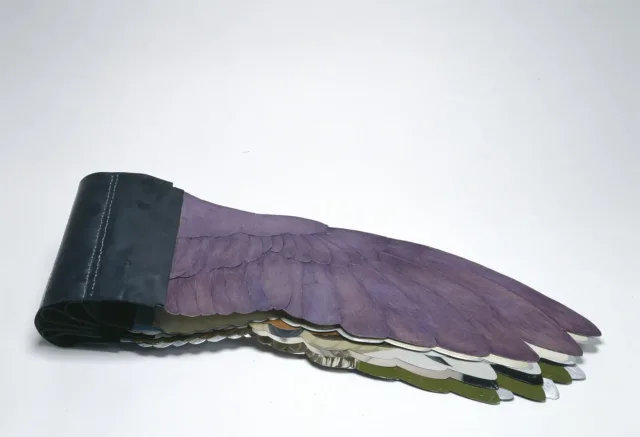
Brenda Watson, Comment attirer les oiseaux (How to attract birds?), 1995; Oil paint on aluminum, rubber, thread, 30 x 10 in.; National Museum of Women in the Arts, Museum purchase: Library and Research Center Book Acquisition Fund

